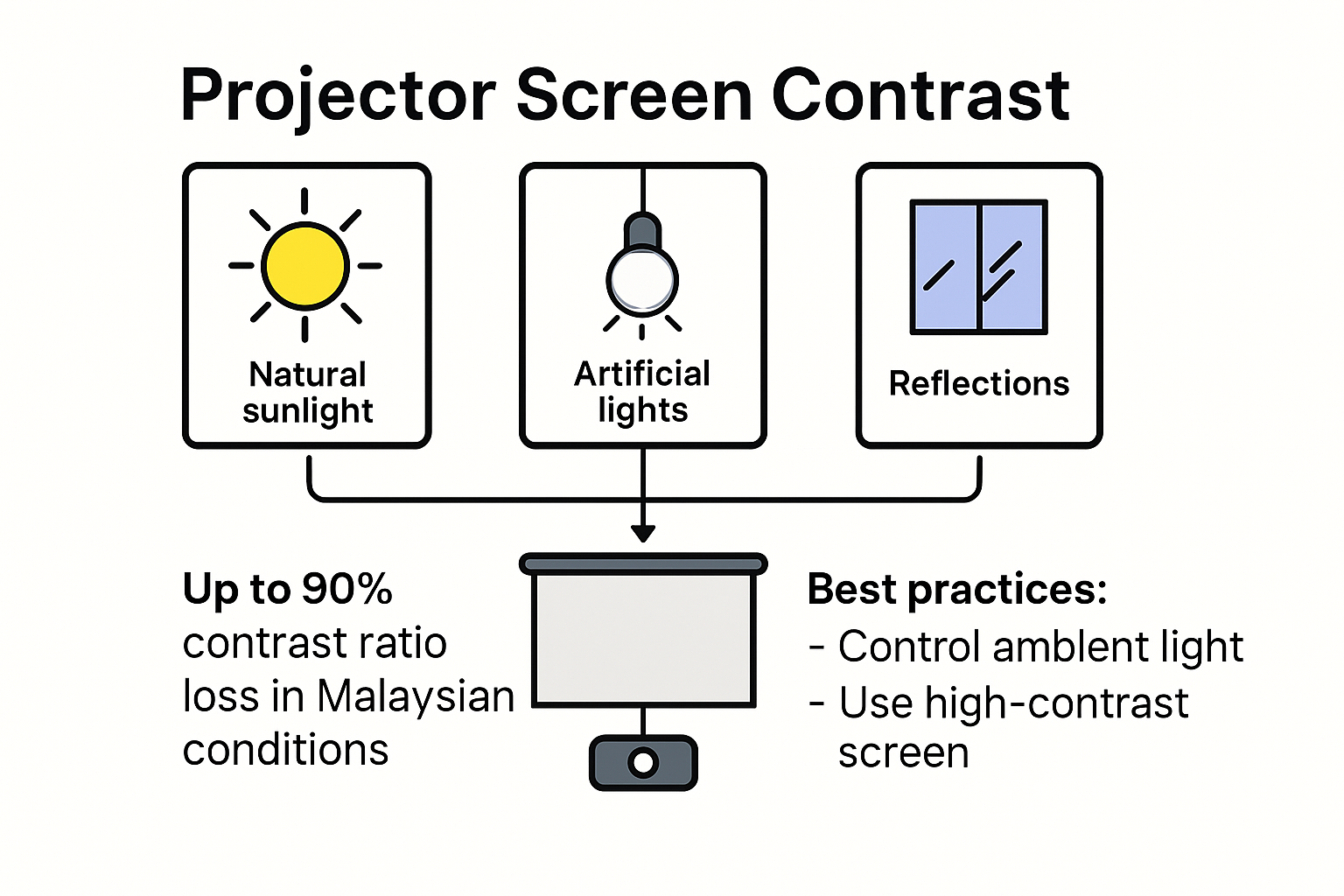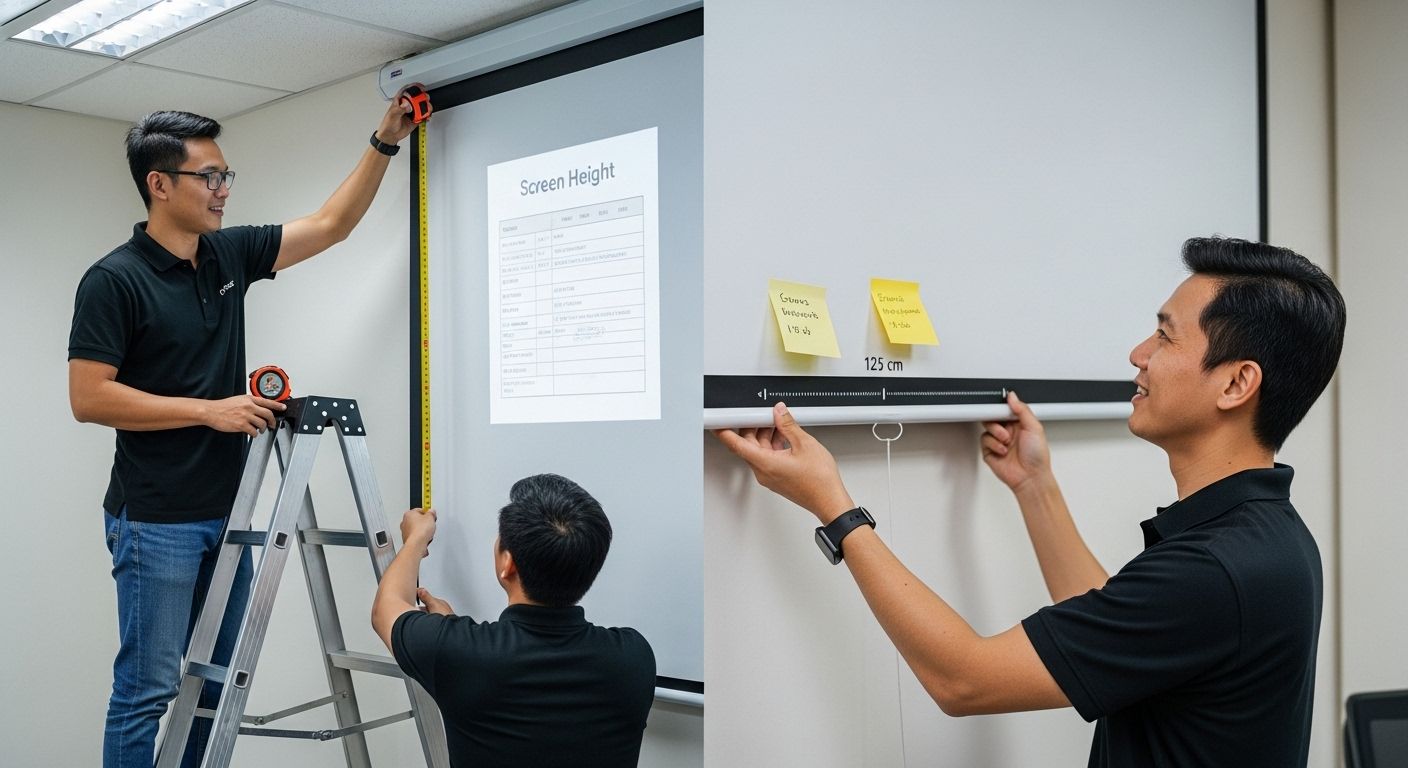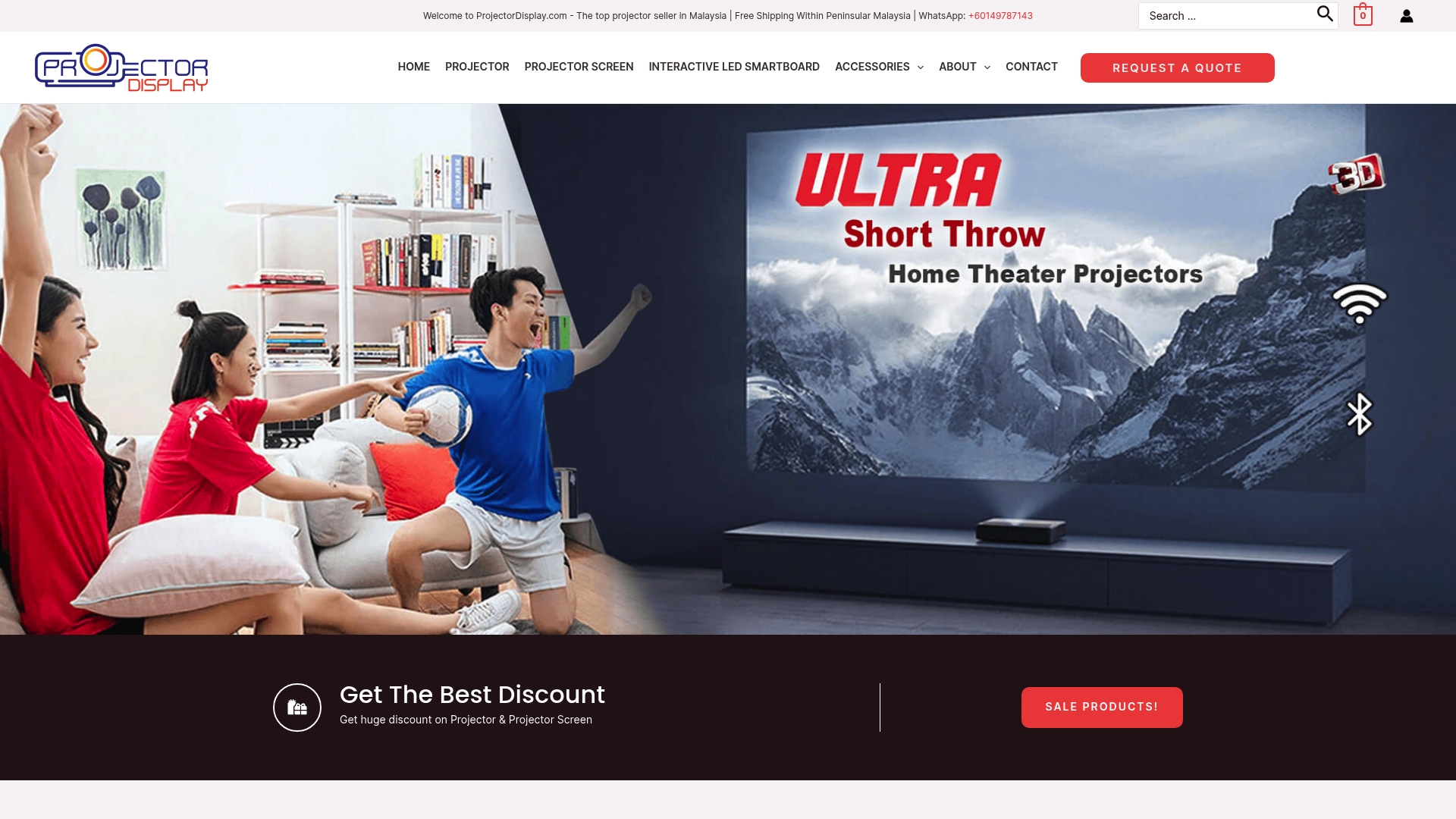{
“@type”: “Article”,
“author”: {
“url”: “https://projectordisplay.com”,
“name”: “Projector Display”,
“@type”: “Organization”
},
“@context”: “https://schema.org”,
“headline”: “Projector Screen Placement Guide for Malaysia Users 2025”,
“publisher”: {
“url”: “https://projectordisplay.com”,
“name”: “Projector Display”,
“@type”: “Organization”
},
“inLanguage”: “en”,
“articleBody”: “Learn the best projector screen placement tips for home, office, or classroom in Malaysia. Maximize image quality and viewing comfort with expert guidance.”,
“description”: “Learn the best projector screen placement tips for home, office, or classroom in Malaysia. Maximize image quality and viewing comfort with expert guidance.”,
“datePublished”: “2025-08-01T05:40:20.948Z”,
“mainEntityOfPage”: {
“@id”: “https://projectordisplay.com/projector-screen-placement-malaysia-guide”,
“@type”: “WebPage”
}
}
Projector screens can transform an average Malaysian living room or office into a powerful viewing experience. Many users try to maximize image size and brightness, but unexpected issues often ruin the picture. Shockingly, direct sunlight can cut your contrast ratio by up to 40 percent, which means even the best projector can look dull if you get placement wrong. There's a smarter approach that goes beyond the projector itself and starts with careful screen position, lighting, and room planning.
Table of Contents
- Key Factors Affecting Projector Screen Placement
- Optimal Screen Heights and Distances
- Room Lighting and Ambient Conditions
- Practical Tips for Malaysian Homes and Offices
Quick Summary
| Takeaway | Explanation |
|---|---|
| Select Optimal Screen Height | Position the screen bottom about 125 cm from the floor for viewer comfort and visibility. |
| Manage Ambient Light | Position screens away from direct sunlight to improve image quality by reducing glare and contrast loss. |
| Consider Room Dimensions | Evaluate room size and layout to determine proper distances between projector, screen, and seating for best results. |
| Optimize Distance for Viewing | Maintain screen height to be 1/6 of the distance to the farthest viewer for enhanced image perception. |
| Use Proper Screen Materials | Choose screen technologies resistant to humidity and optimized for local lighting conditions to ensure durability and performance. |
Key Factors Affecting Projector Screen Placement
Optimal projector screen placement is a critical consideration for Malaysian users seeking exceptional visual performance across home entertainment, business, and educational environments. Multiple interconnected factors determine the ideal positioning of your projection setup, directly impacting image quality, viewing experience, and overall system effectiveness.
Room Dimensions and Screen Geometry
The physical characteristics of your space play a fundamental role in projector screen placement. Malaysian users must carefully evaluate room dimensions, ceiling height, wall surfaces, and available mounting options. Read our guide on screen size selection to understand how room geometry influences screen positioning.
Proper screen placement requires precise measurements and spatial awareness. Factors like room depth, width, and potential obstructions significantly impact projection quality. Experts recommend maintaining specific distances between the projector, screen, and seating areas to optimize viewing angles and minimize visual distortions.
Lighting and Ambient Conditions
Malaysia's tropical climate presents unique challenges for projector screen placement. Ambient light levels, window positions, and natural illumination dramatically affect projection performance. According to lighting research from AV Technology Institute, direct sunlight can reduce contrast ratios by up to 40%, making strategic screen positioning crucial.
Ideal screen placement minimizes light interference by considering:
- Window orientation: Positioning screens away from direct sunlight
- Wall color: Using darker wall colors to reduce light reflection
- Curtain and blind options: Implementing light control mechanisms
Technical Projection Parameters
Advanced technical considerations determine precise screen placement. Throw distance, keystone correction, and projection angle are critical technical parameters that Malaysian users must understand. Projector manufacturers provide specific guidelines for optimal positioning based on lens specifications and projection technology.
Key technical factors include:
- Throw ratio: Calculating the distance between projector and screen
- Vertical and horizontal lens shift: Adjusting projection alignment
- Keystoning: Correcting image distortion caused by improper angle
Professional AV integrators recommend using manufacturer-provided calculators to determine exact screen placement. Understanding these technical nuances ensures maximum visual performance across different projection environments in Malaysia.
By comprehensively analyzing room dimensions, lighting conditions, and technical projection parameters, Malaysian users can achieve exceptional screen placement that transforms their viewing experience.
To help summarize the key factors affecting projector screen placement in Malaysia, the following table organizes the three main considerations, their descriptions, and relevant strategies or tools mentioned:
| Factor | Description | Relevant Strategies/Tools |
|---|---|---|
| Room Dimensions & Geometry | Influence screen position, size, and viewer distance | Measure depth, width; check ceiling; assess mounting options |
| Lighting & Ambient Conditions | Affect image contrast and clarity due to natural and artificial lighting | Manage sunlight, use darker wall colors, install curtains/blinds |
| Technical Projection Parameters | Impact image quality based on technical specs (throw, alignment, etc.) | Use manufacturer calculators, adjust throw ratio, correct keystoning |
Optimal Screen Heights and Distances
Selecting the perfect screen height and distance is crucial for creating an immersive visual experience in Malaysian home theaters, classrooms, and professional environments. Understanding the intricate relationship between screen placement, viewer positioning, and room dynamics ensures optimal projection performance.
Vertical Positioning and Viewing Angles
The vertical placement of a projection screen dramatically impacts viewer comfort and visual perception. Explore our comprehensive screen size guide to understand precise positioning techniques. According to Legrand AV's Projection Screen Academy, professional settings require the bottom of the screen to be approximately 125 cm from the floor, ensuring clear visibility for all audience members.
Ergonomic considerations are paramount. THX recommends that viewers should not need to look up more than 15 degrees to see the screen's top, which minimizes neck strain and promotes comfortable viewing experiences. This principle applies equally to home entertainment systems, conference rooms, and educational spaces across Malaysia.
Distance Calculations and Viewer Optimization
Precise distance calculations transform projection quality. ProjectorCentral's Classroom Projector Buyer's Guide suggests that screen height should represent approximately 1/6 of the distance to the farthest viewer. For instance, if the maximum viewing distance is 30 feet, the screen height should ideally be 5 feet.
Key distance optimization strategies include:
- Minimum viewing distance: Preventing visual fatigue by maintaining appropriate screen-to-viewer proximity
- Maximum viewing distance: Ensuring detailed content remains legible across the entire audience
- Aspect ratio considerations: Adjusting screen dimensions to match projection technology
Technical Placement Recommendations
Technical precision determines projection excellence. Malaysian users must consider multiple factors when establishing screen heights and distances. Projector throw ratios, lens specifications, and room geometries interact complexly to influence optimal placement.
Professional AV integrators recommend advanced techniques such as:
- Laser distance measurement: Utilizing digital tools for precise screen positioning
- Projection angle calculations: Minimizing keystoning and image distortion
- Multi-point calibration: Ensuring consistent image quality across different viewing positions
By meticulously analyzing vertical positioning, calculating optimal distances, and applying technical placement strategies, Malaysian users can create visually stunning projection environments that deliver exceptional viewing experiences across diverse settings.
The following table summarizes recommended optimal screen heights and distances based on the guidance and examples provided in this section:
| Placement Aspect | Recommended Value/Guideline | Purpose |
|---|---|---|
| Screen Bottom Height | ~125 cm (approx. 4 ft) from floor | Ensures clear and comfortable visibility |
| Max Vertical Viewing Angle | ≤ 15° to top edge | Reduces neck strain for viewers |
| Screen Height : Farthest Viewer Distance | 1 : 6 | Maintains image clarity and detail for all viewers |
| Example: Max Viewing Distance 30 ft | Screen height should be 5 ft | Real-world application of guideline |
Room Lighting and Ambient Conditions

Room lighting represents a critical yet often overlooked factor in achieving optimal projector screen performance across Malaysian home, office, and educational environments. The complex interplay between natural and artificial light sources directly impacts image quality, contrast, and overall viewing experience.
Impact of Natural Light Interference
Malaysia's tropical climate introduces unique challenges for projection systems due to intense and consistent sunlight. According to lighting research from AV Technology Institute, direct sunlight can reduce projected image contrast by up to 40%, dramatically compromising visual clarity.
Learn more about managing projection environments by understanding how different light sources interact with projection surfaces. Strategic window positioning, utilizing light-blocking curtains, and selecting appropriate screen materials can significantly mitigate natural light interference.
Key strategies for managing natural light include:
- Window orientation assessment: Identifying potential light entry points
- Directional screening: Using adjustable blinds or specialized window films
- Reflective surface management: Minimizing glossy wall and floor surfaces that amplify light scatter
Artificial Lighting Optimization
Artificial lighting configurations play an equally crucial role in projection performance. Professional AV integrators recommend carefully planned lighting setups that complement projection requirements. Illumination Engineering Society guidelines suggest maintaining ambient light levels below 10-15 foot-candles for optimal projection quality.
Effective artificial lighting strategies involve:
- Dimmable lighting systems: Enabling precise light level control
- Indirect lighting techniques: Reducing direct glare and reflection
- Color temperature management: Selecting lighting that enhances projected image perception
Screen Surface and Light Interaction
Projection screen materials significantly influence light management capabilities. Different screen technologies offer varying levels of ambient light rejection, crucial for Malaysian environments characterized by high humidity and bright lighting conditions.
Advanced screen technologies provide specialized solutions:
- High-contrast gray screens: Enhancing image depth in brighter environments
- Micro-perforated surfaces: Maintaining sound transparency while managing light
- ALR (Ambient Light Rejection) screens: Specifically designed to minimize external light interference
Professional projection experts emphasize that understanding and strategically managing room lighting is not merely a technical consideration but a comprehensive approach to creating immersive visual experiences. By carefully analyzing natural and artificial light sources, selecting appropriate screen technologies, and implementing intelligent lighting strategies, Malaysian users can transform their projection environments, ensuring consistently superior visual performance across diverse settings.
Practical Tips for Malaysian Homes and Offices
Projector screen placement in Malaysian environments demands strategic consideration of unique architectural, climatic, and spatial challenges. Successful implementation requires a nuanced approach that balances technical requirements with practical constraints inherent to home and office settings.
Room Configuration and Space Management
Explore our comprehensive screen selection guide to understand spatial optimization techniques. Projector Reviews recommends painting room walls and ceilings in darker colors to minimize light reflections and enhance projected image quality. Malaysian users must carefully assess room dimensions, ceiling heights, and potential mounting locations to create optimal projection environments.
Key spatial considerations include:
- Furniture arrangement: Ensuring unobstructed projection paths
- Ceiling clearance: Maintaining adequate space for projector mounting
- Cable management: Organizing connections to prevent visual clutter
Tropical Climate Adaptation Strategies
Malaysia's humid environment presents unique challenges for projection systems. According to Projector Central, screen gain and viewing angles become critical factors in managing image quality under challenging environmental conditions. Professional integrators recommend specialized strategies to protect equipment and maintain optimal performance.
Critical adaptation techniques include:
- Ventilation considerations: Preventing heat and moisture buildup
- Dust protection: Using protective covers for projectors and screens
- Humidity control: Implementing dehumidification solutions in projection areas
Screen Selection and Mounting Techniques
Choosing the right screen technology is crucial for Malaysian homes and offices. Wikipedia's projection screen research highlights the importance of selecting appropriate screen materials that can withstand local environmental conditions while delivering superior visual performance.
Advanced screen selection strategies involve:
- Material durability: Choosing screens resistant to humidity and temperature variations
- Mounting flexibility: Implementing adaptable mounting solutions
- Multi-purpose functionality: Selecting screens suitable for various presentation and entertainment scenarios
The table below summarizes three main challenges of projector screen placement in Malaysia alongside actionable solutions and best practices introduced throughout this section:
| Challenge | Solution/Best Practice | Example/Tool |
|---|---|---|
| Light Reflection | Paint walls/ceilings dark; arrange furniture properly | Dark paint, careful layout |
| Humidity & Climate | Improve ventilation; use dehumidifiers; protect screens | Vent fans; screen covers |
| Equipment Durability/Flexibility | Use durable, flexible-screen materials & mountings | Humidity-resistant screens; adjustable mounts |
Successful projector screen placement in Malaysian environments requires a holistic approach that combines technical expertise, environmental awareness, and strategic spatial planning. By carefully considering room configurations, adapting to tropical climate challenges, and selecting appropriate screen technologies, users can create exceptional projection experiences that meet the unique demands of home and office settings across Malaysia.

Frequently Asked Questions
What is the optimal height for projector screens in Malaysian homes?
The bottom of the projector screen should be positioned approximately 125 cm (about 4 feet) from the floor to ensure clear visibility and viewer comfort.
How can I reduce the impact of natural light on my projector screen?
To reduce natural light interference, position screens away from direct sunlight, use darker wall colors, and install adjustable curtains or blinds to control light levels.
What distance should I maintain between the projector and screen for best viewing?
It is recommended that the screen height should be approximately 1/6 of the distance to the farthest viewer to maintain image clarity and detail.
What materials should I consider for projector screens in humid environments like Malaysia?
Choose screen materials that are resistant to humidity and are designed for ambient light rejection, such as high-contrast gray screens or ALR (Ambient Light Rejection) screens, to ensure optimal performance.
Transform Your Malaysian Projection Experience Today
Struggling with poor image quality due to sunlight glare or awkward screen placement? You are not alone. Many Malaysian users find that even the best projector setup falls short without the right screen position, distance, and ambient light control. The article has shown how direct sunlight and room dimensions can hurt your contrast, comfort, and overall viewing experience. If you want crisp, vibrant visuals every time, your next step is to select a screen designed for your unique space and lighting conditions.

Take charge of your environment now. Discover advanced screen options for Malaysian homes and offices in our Projector Screen selection and browse cutting-edge solutions on ProjectorDisplay.com. Our expert team is ready to help you choose humidity-resistant screens, flexible mounts, and everything else you need for flawless projection. Do not let another movie night or important presentation be ruined by a faded image. Shop with us today for fast shipping and supportive guidance every step of the way.

